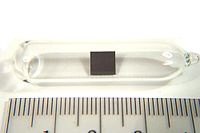
Photo from wikipedia
Abstract The stability and clustering behavior of fission products (Zr, Mo, Ru, and Rh) in thorium dioxide have been investigated by density functional theory. The calculations were performed considering the… Click to show full abstract
Abstract The stability and clustering behavior of fission products (Zr, Mo, Ru, and Rh) in thorium dioxide have been investigated by density functional theory. The calculations were performed considering the possible insertion sites in ThO2, including interstitial sites, thorium vacancies, oxygen vacancies, the oxygen–thorium divacancy, and three types of Schottky defect. The thorium vacancy is the most energetically favorable trap site for all of these fission products. Zr and Mo can exist as oxide precipitates whereas Rh and Ru tend to form metallic clusters in ThO2. Moreover, Ru and Rh dimers are the most stable clusters in the Schottky defect in ThO2, suggesting that metal clusters in ThO2 may be formed of these dimers trapped in Schottky defects.
Journal Title: Computational Materials Science
Year Published: 2017
Link to full text (if available)
Share on Social Media: Sign Up to like & get
recommendations!